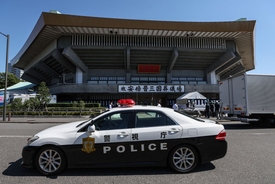Aokigahara forest, at the base of Mount Fuji, is where YouTube personality Logan Paul found himself in December 2017. He and his team discovered a hanging corpse but kept the cameras rolling. The video then went viral for all the wrong reasons.
Regardless of how you feel about Logan Paul, his actions or his apologies, the video shed light on an issue all too prevalent in Japan. Karōshi culture, where workers toil for weeks at a time without a day off, has created a fractious and fatigued society.

"Karōshi" literally translates to “overwork death” and, in July 2013, 31-year-old Miwa Sado proved this to be more than just phrase. Employed by the country’s public broadcaster, NHK, she logged 159 hours of overtime in one month before dying of heart failure.
Technically, this is uncommon. A more likely outcome is that the worker attempts suicide. This is due in part to the overwhelming pressure not to dishonour one’s boss, one’s family or oneself. There exists in Japan a very dangerous idea that you should never show signs of weakness - which also means that subjects such as self-harm, depression and suicide are far more taboo than they are in the west.

However, the culture of honour and overwork is now showing signs of having leeched into youth culture too. Recent figures show that 250 elementary and high school age children took their lives in Japan between 2016 and 2017. The government had previously noticed an annual spike on 1 September - when children go back to school after the summer.
"The long break from school enables you to stay at home, so it's heaven for those who are bullied," then-highschooler Nanae Munemasa told CNN in 2015. "When summer ends, you have to go back. And once you start worrying about getting bullied, committing suicide might be possible."

The newly-published figures show Japan’s youth suicide rate to be at its highest since 1986 - when 268 children took their lives. "The number of suicides of students have stayed high, and that is an alarming issue which should be tackled," stated ministry official Noriaki Kitazaki, who said the cause of this increase was unclear.
This trend coincides with the fact that the youth suicide rate was up last fiscal year. That said, according to the National Police Agency, the total number of suicides in Japan fell to 21,321 in 2017, from a peak of 34,427 in 2003.

Japan's government announced plans in 2016 to reduce suicides by 30 per cent by 2026. The initiative, which particularly aims to target young people at risk, includes launching a 24-hour helpline and employing counsellors for every elementary and junior high school.
"We'd love to eliminate such tragedies altogether, but the reality is several hundred children are taking their lives (each year)," education ministry official Koju Matsubayashi told Japan Times. "It's important to teach children how to get help as soon as possible ... because it becomes harder and harder to find help once they're already suffering. The light at the end of the tunnel gets darker and darker until they begin to start seeing the light at the end of the tunnel as death."

In Japan, there remains a stigma attached to suicide which, in turn, leads to more suicides. The cycle of silence and suppression stifles conversation on the topic - meaning that those with issues such as depression often feel they have to face it alone.
The notoriety around Aokigahara forest is a lasting testament to the devastating effects of this trend. The forest played host to 247 suicide attempts in 2010, 54 of which were fatal. In recent years, however, authorities have stopped publishing statistics on suicides here in order to try and dissociate Aokigahara from the idea of suicide.

The trend itself is widely thought to have originated from Seichō Matsumoto's 1961 novel Nami no Tō (Tower of Waves). However, it was known as a site for suicide far before this. Meanwhile, rail operators have erected chest-high track barriers and installed blue-tinted lights which are intended to calm people's mood.
Clearly, these responses aren't tackling the root cause. Data for 2014 showed that, for the first time, suicide was the most common cause of death among those aged 10 to 19. It continues to prevail as a scourge of Japanese society, both in terms of its devastating effects and the way in which it is dismissed. Only with a greater level of care and understanding will the situation ever improve.

